Charge! Or How to Play War Games by Brig. P. Young and Lt. Col. J.P. Lawford, presents the gamer two sets of rules, elementary and advanced, covering European warfare from 1756 to 1815. The authors state they chose this period, “because troops for the most part, still fought in close order and no War Game table is big enough to deploy the armies of modern times”. Flames of War players may disagree with that statement but at that time of publication this time period, especially the “Napoleonic” period was probably the most popular in the gaming community. The Boardgamegeek.com entry for Charge* calls this book “one of the two foundation texts establishing the modern miniatures war game”. I find that the elementary rules serve as a great introduction, while the advanced rules still hold their own. At the very least they provide an excellent framework upon which one can develop one’s own preferences.
The first chapter is an essay on the origins of war gaming. The authors admit that “It is not known when intelligent generals and statesmen, finding the perils of actually fighting a war and the penalties for defeat excessive, turn to less exacting imitations”. They guess that Chess may have been the first war game but explain that the game was never intended to be a training tool or historical simulation. A mention is made of the invention of military chess by a “versatile German” (George Von Rassewitz). In this version the two players sit in different rooms and pass their moves to an umpire who informs the players if their move is permitted or not, which is an attempt to introduce the “fog of war”. Von Rassewitz was influenced by simulations developed by the Prussian general staff (later adopted throughout Europe after Prussia’s decisive victory in 1870). Military chess was influential enough that one of Avalon Hill’s foundation board games, Kriegspiel, was advertised as a military chess game, despite totally breaking with the limitations of the chess board and pieces.
Recognition is given to H.G. Wells’ book, Little Wars, where “actual model soldiers, not symbols, faced each other….” and all the firing was conducted by cannon firing wooden pellets. The authors state that Wells’ rules led to “….some rather odd handling of the guns and relegated infantry largely to the role of cannon-fodder”, thought they point out that the book was first published in 1913 and “….may not have been so very inaccurate”. The chapter concludes with a statement of game philosophy that that amateur war gaming does not require long and complicated rules to reproduce “unquestionable accuracy” to generate the tensions and excitement of battle. Miniature gaming excites “….an interest in history and the pageantry of the past”, leading to the understanding of the course of historic battles and the factors governing the tactics of the commanders.
In the spirit of understanding the factors governing the tactics of the commanders, Charge is really a hybrid containing rules enhanced with explanatory discussions of tactics, weapons, leadership and facts. For example, in the elementary rules, before stating that Cavalry is allowed to move up to 12 inches a turn, “Cavalry at the walk went a four miles per hour, at the walk and trot five miles an hour, at the trot eight miles an hour and at the gallop twelve miles per hour ”. To explain the different types of cannon fire in the rules; “Grape and canister (YOS – types of cannon shot) on the other hand had to be treated with respect. Grape consisted of some eight or nine balls each weighing two to three pounds and held together by a tightly laced canvas bag. It received its name because the canvas bag, bulging with these balls, looked not unlike an oversize bunch of grapes. Canister was no more than a can containing about a hundred assorted small shot, nuts, bolts or any similar old ironmongery that came to hand. The container of the projective dissolved as it left the gun muzzle and sprayed its contents on any unhappy soldiery who happened to be in front of it. Canister had a very short range; grapeshot, being heavier, carried farther, but was not much used at ranges greater than 350 yards”.
Finally, Charge follows both rule sets with a scenario and accompanying turn by turn accounts of gameplay with pictures using narrative to explain the game mechanics.
A friend and I decided to play the elementary game scenario: The Action at Blasthof Bridge. This fictional encounter had The Emperor’s forces face off against the Elector’s. I’m guessing that the authors had a poor view of generalship in the late 18th Century as the Elector’s general, Soubise is introduced thusly: “Why he chose Soubise it is difficult to say, as that General up to this time had shown an almost pathological inability to win a military action – or even take part in one. He owed his selection to his handsome uniform, rather than any unsuspected talent”. Opposing him was the Count von Kornberg: “…a dashing and experienced cavalryman – more notable for dash than for brain”. My guess the reason these mediocrities appear in the narrative is that leaders don’t play any role in the basic game. They are there to view the battle but do not effect morale, give bonuses, etc. Unfortunately, this also holds true in the advanced rules, which are otherwise detailed and well thought out.
Since I do not have 18th Century figures we used figures from a 15mm Napoleonic French Army. Looking at the book’s accompanying pictures it seems they used at least 54mm figures. To those new to miniature gaming the usual procedure is that each unit represents more than one individual soldier. Depending on the rule set one figure could equal any number of individuals. Basically, smaller figures allow a collector to build bigger armies, therefore each figure may represent less number of men. Larger figures are more expensive but easier to paint (though more detail is required in the painting for a passable figure) and tend to represent more. In this case, the figures actually represents an individual foot soldier or cavalryman. In the advanced rules the representation is about 5 soldiers though you will find that contemporary rule sets allow for a greater number of troops represented by fewer figures.
The introduction to Action at Blasthof Bridge begins with the “required tools” necessary to play the game: “In addition to your soldiers you need an open space where you can play undisturbed, two dice cups and three or four dice**, a couple of ordinary geometry rules, each measuring a foot, a template for checking the angle of artillery and musketry fire, and a long thin batten, three feet in length (which the authors go on to explain are for measuring gun ranges and require a mark every six inches). For the novice I would say the hardest part is acquiring the miniatures and that is only a quick click or two away on Amazon or eBay. Way back when, the board game Risk used to come with colored wooden blocks and those could be used in a pinch as soldiers (though for a large game you would need to base them as moving each individual one would be too painful). When using these rules I only need dice and a foot long ruler (i.e. the geometry rule). It was easy enough to figure 45 degree angles from the gun barrel. In the bonus section at the end of this review you will find some YOS recommended game enhancements.
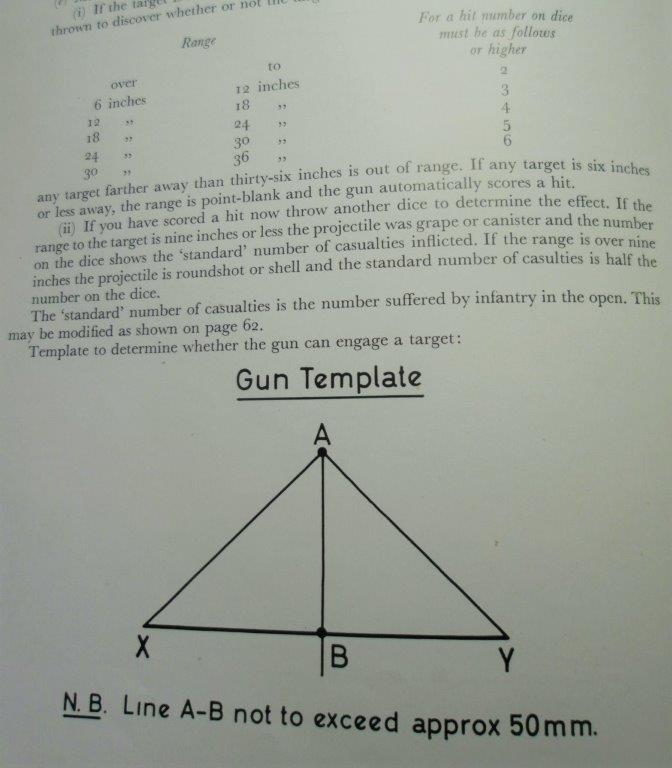
The scenario map calls for a playing field at least 6 x 4 feet though we played on a table only 5 x 3 ½ feet. Interestingly, at the end of the turn chapter the authors state that an area of approximately 5 x 3 feet is required though 5 x 4 is preferable.
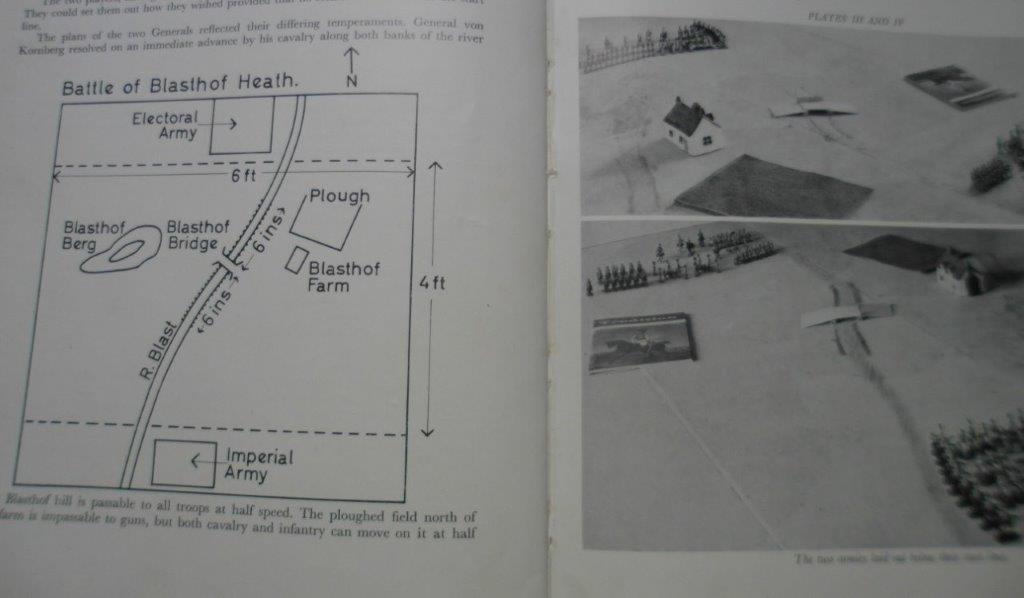
Note the pictures on the right with the authors’ set up and booklet that serves as the hill. The title is “Tradition” and a quick internet search comes up blank. The bridge in the middle of the map is the focus of the scenario. General Soubise must destroy or at least hold the bridge by the end of the scenario.
My opponent played the Electoral side. Soubise’s force included his A.D.C, 12 dragoons plus an officer and 40 infantry with three officers along with two guns accompanied by 10 gunners and an officer. Unfortunately, I didn’t have enough gunner figures and they play a vital role in the game since if the gun crews take enough casualties they can no longer fire. In this case we kept a paper tally of our gun crew’s casualties.
For anyone playing close attention our armies started on opposite sides than the map above displays. In our case the Electoral forces started from the southern end.
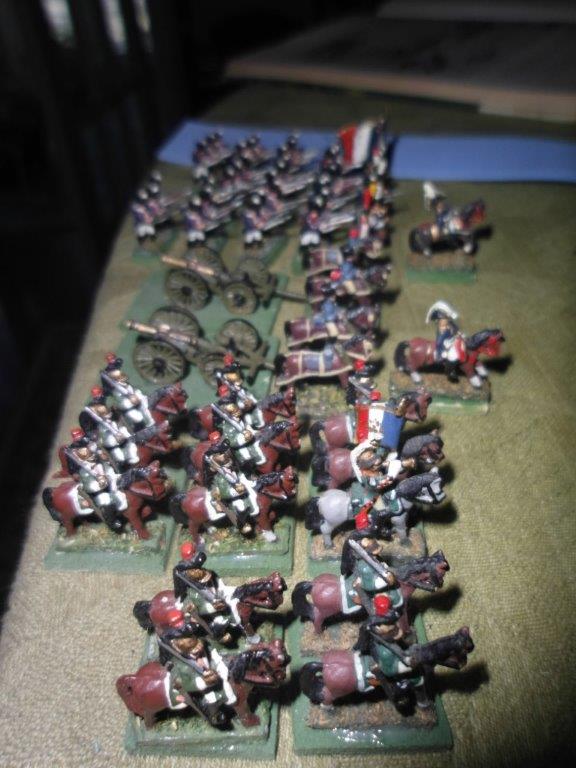
My Imperial troops consisted of the General, his A.D.C, 16 cuirassiers and two officers, 32 infantrymen and two officers, along with two guns with five gunners each. Most of my cavalry has been ordered to immediately cross the stream and have formed a column heading east behind the line of infantry.
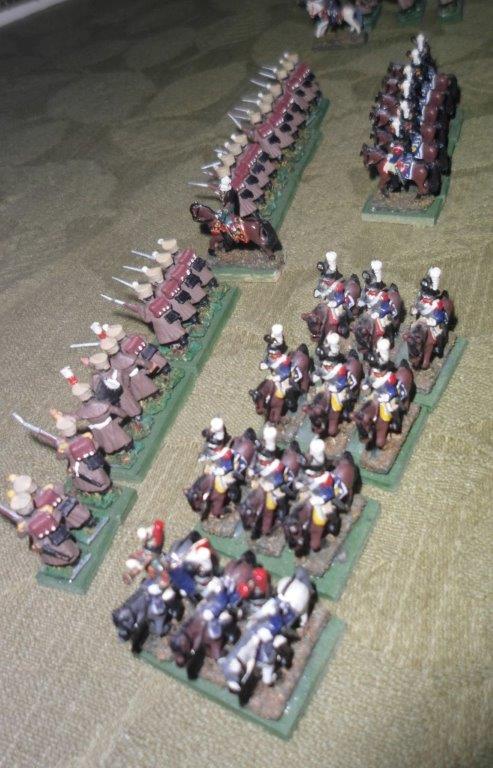
My opponent chooses to unlimber his guns early. He’ll get the first shots of the game but will fire from a greater distance with less chance to hit…
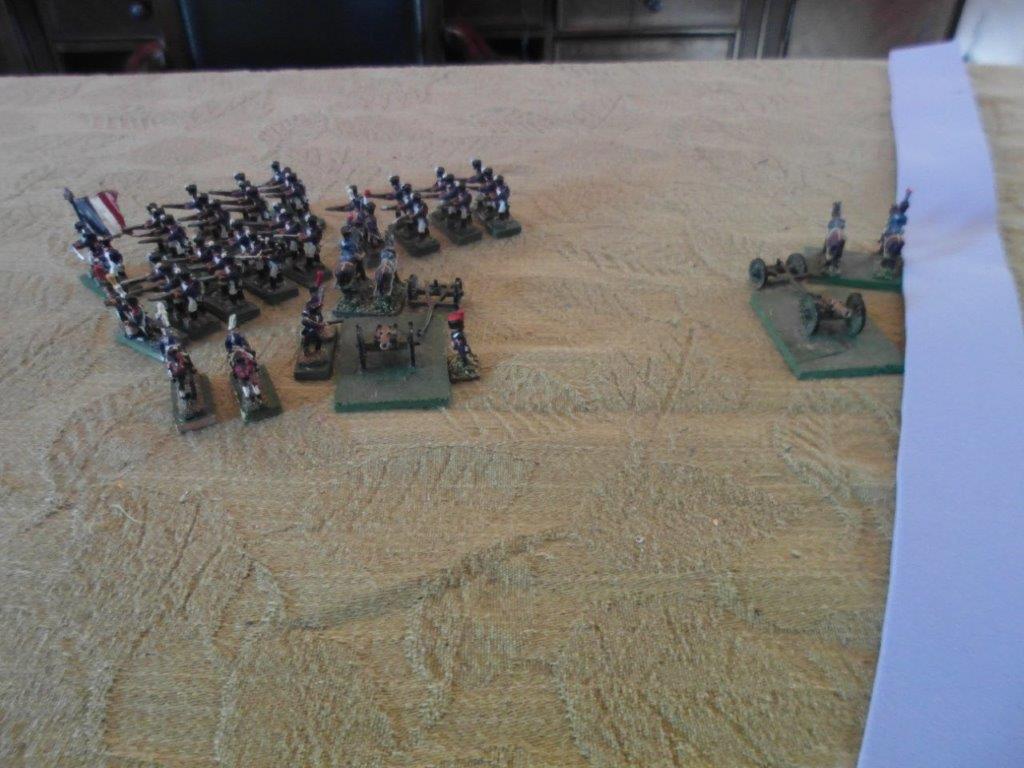
…unless I move in closer.
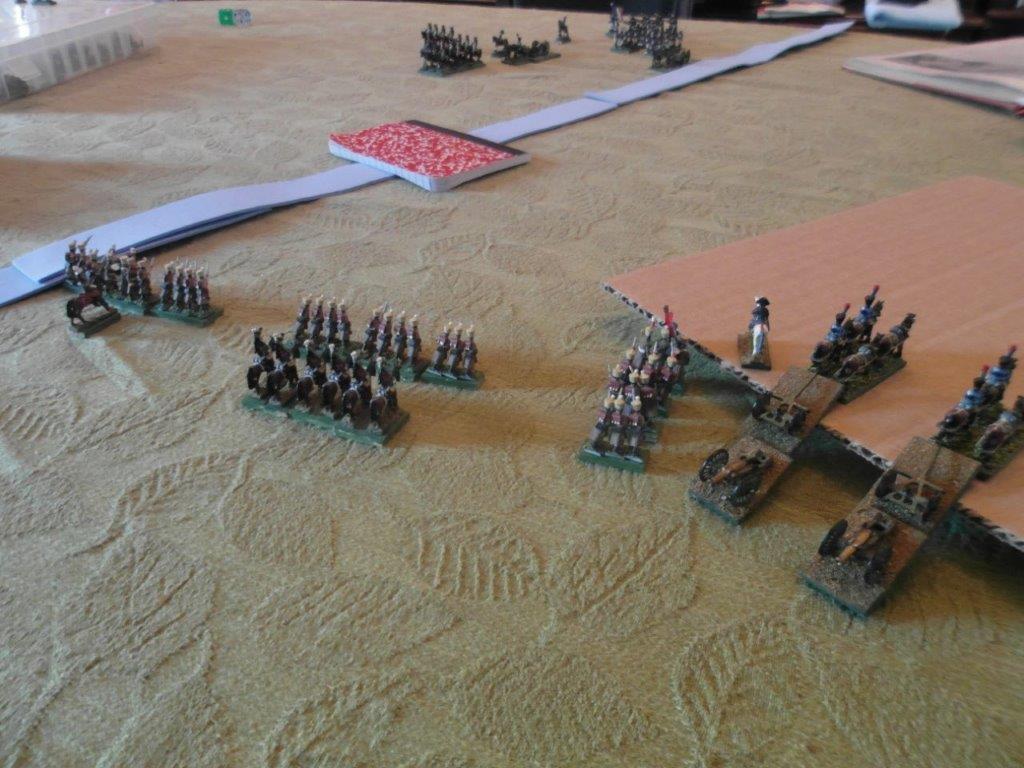
My guns were ordered to take a commanding position on the hill top above the bridge. I thought it was a good idea at the time but moving forward allowed my opponent a couple of turns of unanswered fire. By the time the guns were unlimbered and ready to fire they were immediately degraded in effectiveness. My ineffective counter battery fire could never disrupt the enemy gunners before both of my gun crews were decimated.
Yes, the little red booklet serves as the bridge. Have to use some imagination here. I figured it was better than using the only other bridge at hand:
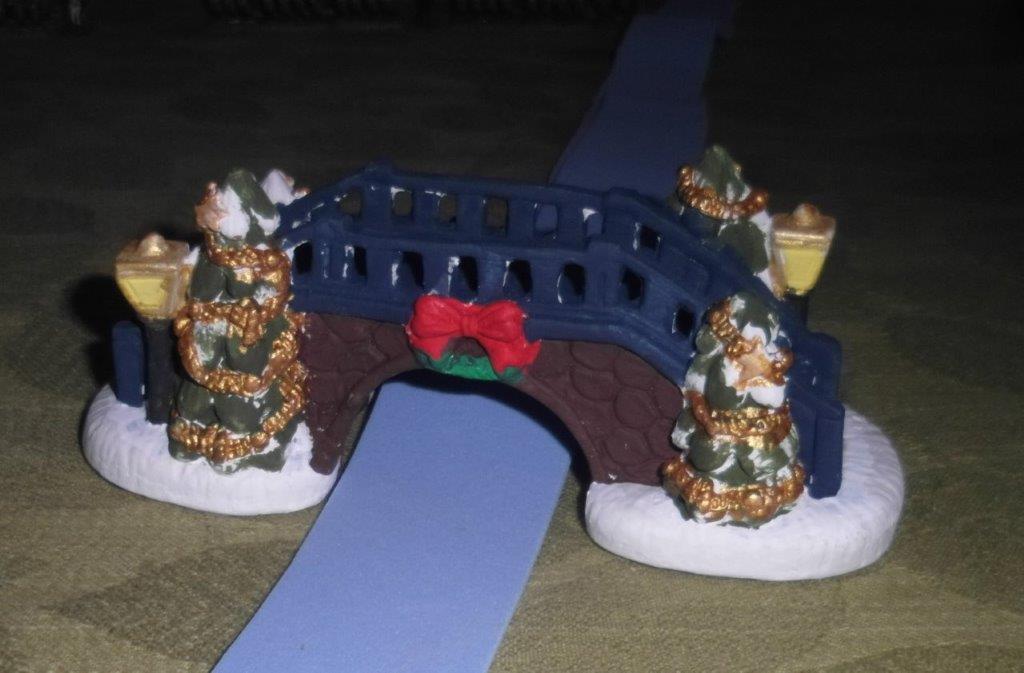
While the gunners were dueling my infantry had rushed forward to take the bridge as the cavalry skirmished close by the farm house. I had the advantage early with my infantry firing on the flanks of the enemy’s cavalry but their infantry was fast approaching.
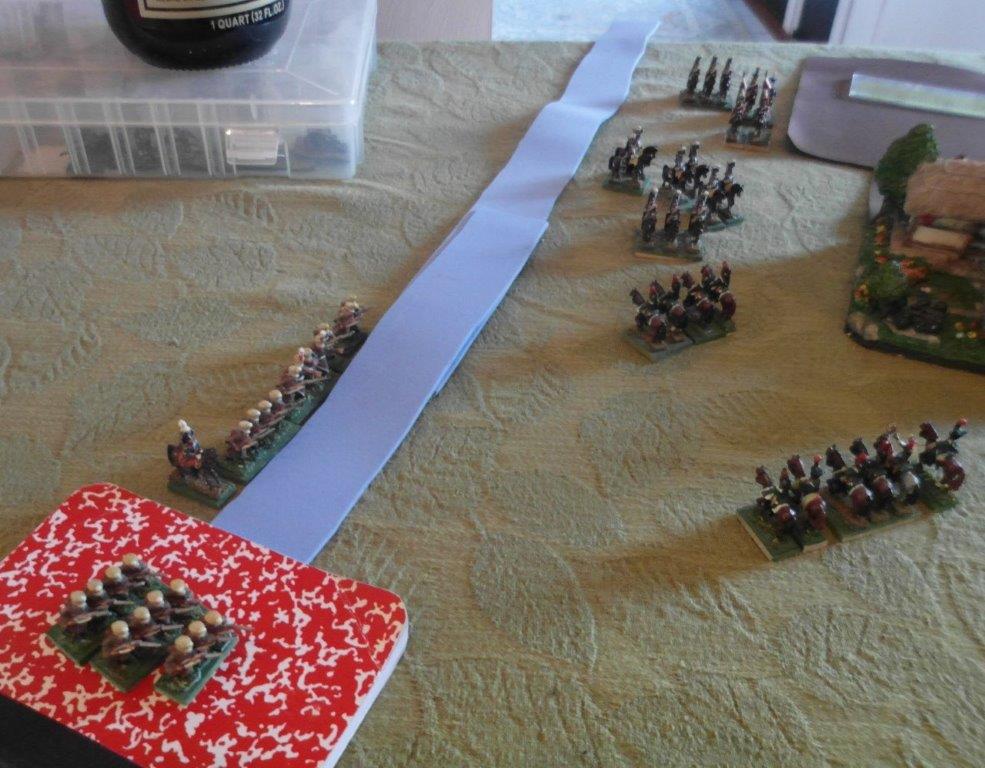
The picture below shows the cavalry action by the farm house as an enormously large chicken looks on. Bonus points if one can tell which country the farm house actually belongs instead of on a European battlefield.
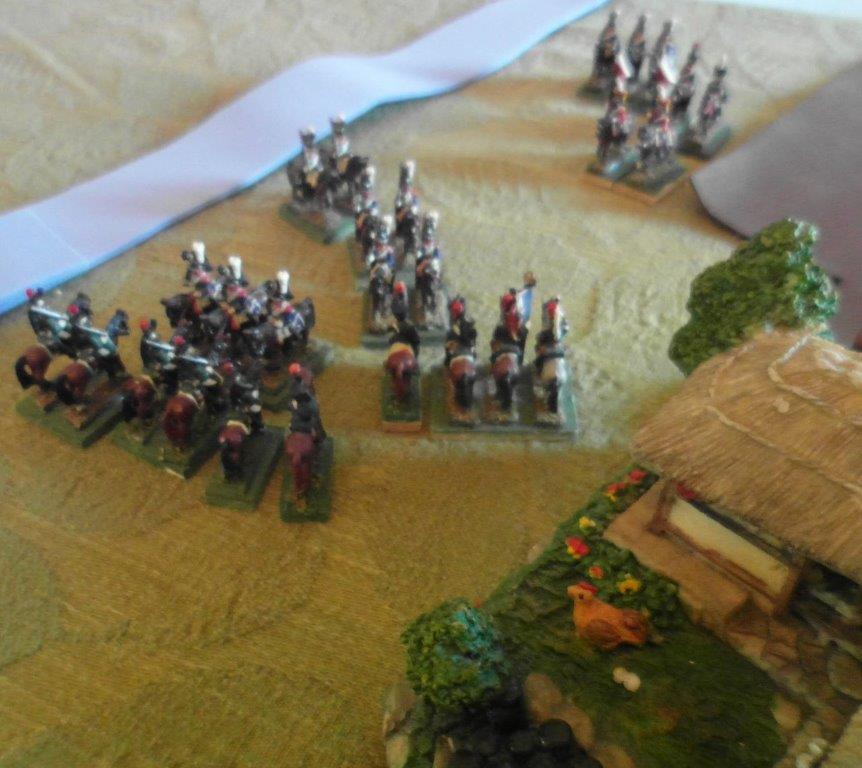
The elementary rules have both sides retreat a few inches after a melee so this combat was a process of charge, fight, retire and charge again; for about three turns. My opponent’s cavalry would retreat and my infantry across the stream would fire upon them while they reorganized for another advance.
Despite the losses taken from my troops shooting across the stream the enemy cavalry was getting the upper hand and my infantry was taking heavy fire. Ordering an all or nothing charge was only chance left. I would have lost a musketry duel as the enemy’s cannon was now free to turn their attention to my troops. Charging forward and engaging in a melee gets my troops out of site of the guns.
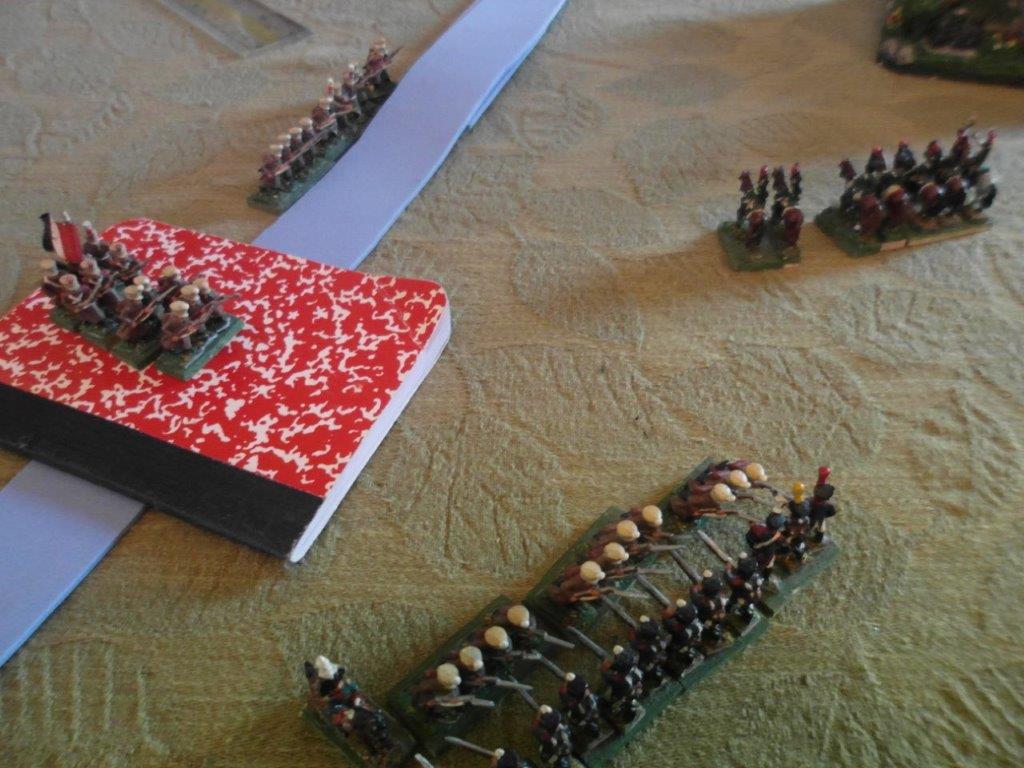
Needless to say my last gamble didn’t pay off and the surviving troops surrender. All told the combat took seven turns out of the allocated fifteen. General Subise managed to escape and after becoming persona non-grata at court found service in the Ottoman Army where he continued his losing ways against the Russians.
The advanced rules are quite specific about unit organization and the formations used on the battlefield. Movement rates go beyond the simple 6 inches for infantry and 12 for cavalry of the elementary game and get quite detailed. For example, infantry can move 6 inches and fire, move 9 inches in line or square and 15 inches in columns with Light Infantry able to move up to 18 inches without firing. Of course, with these movement rates one would need a greater playing area (if not available just cut the movement and firing distances in half).
The advanced rules go into tremendous detail when simulating melees. Extensive explanations and examples from game play are given for the following multitude of possible melee actions: cavalry v. cavalry, musketry fire in melees, cavalry v. infantry in open order and in closed order, cavalry v. infantry in square, infantry v. infantry in close and open order, melee at a breastwork or redoubt, accidental melees (both units trying to move into the same space at the same time without intending to charge), attacks on houses, attacks on fortifications, mixed melee with cavalry and infantry and finally, artillery unfortunate enough to be caught in a melee. The ratio of casualties between the sides will determine the winner or if the outcome is indecisive. The losing ride must yield prisoners at a scale of one prisoner for every five casualties suffered and the winning side’s men will reform sooner than the loser.
The best feature of the advanced rules is the simultaneous movement. At the beginning of each turn the players write down their orders for each unit. If a player fails to write orders for a unit at the beginning of the turn then the unit will not act that turn. This is the reason for the rules covering accidental melees mentioned above, a situation that does not occur in an “I go, you go” structured game. I’ve known players that have taken this concept to the next level by having written orders sent to units by messengers. A unit will act on the last order received and there is a time lag between issuing the order and the distance the messenger has to ride to deliver the orders.
Overall, Charge is an enjoyable read and a rule set that stands the test of time. Keep an eye out for this one at used book stores or at yard sales. Seems the cheapest copy on offer is around $50 and from there upwards into greater realms of unreasonableness to over $600. If one was serious about miniature wargame history then $50 might be fine but I wouldn’t shell that out for idle curiosity.
The opening chapter stated that H.G. Wells’ Little Wars provided a framework for amateur war-gaming which has been elaborated and built on through the years. I can give Charge no higher praise that by saying the same for it.
* https://boardgamegeek.com/boardgame/30546/charge-or-how-play-war-games gives the book’s publishing date as 1970 but my copy states 1967. May be U.S. and British editions.
** A minor complaint about the book is that the authors used the term “dice” interchangeably with “die”. My Dad used to complain about that but “die” is singular and “dice” plural.
YOS Bonus:
As part of Ye Olyde School’s Community Service project I offer an enhancement to Charge’s required tools for playing. You may notice the bottom of a quart in one of the scenario photos.
That bottle would be the excellent Corona Familiar!
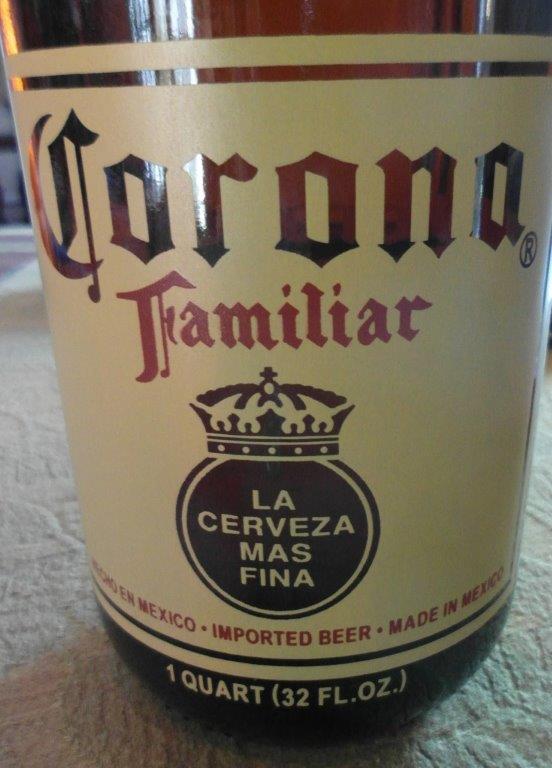
Orale!
I don’t know where you come down on the immigration debate but before playing a war game I’m almost always heading down to the local Latin American food shop, bodega or what have you and picking up a few of these numbers. In my area Corona Familiar was available in many supermarkets but availability has dropped off. I heard it described as “too expensive”. It’s not too expensive if there’s some good beverages to accompany your gaming.
This recommendation is coming from a guy who made it a principle in the 80’s not to drink Corona as it was the drink of choice of the college set. It’s worth a taste if you haven’t tried it already.
My local also serves Regia from El Salvador and also recommend for those that like a light lager.

I never thought I would recommend it but also have to go with Gallo beer from Guatemala. Not as much taste (still good) as the other two but the price makes it worthwhile. In Guatemala some will drink it with added salt, both for flavor and they claim health to combat salt loss through extreme sweating. If Gallo is available I’ll pick up a couple to accompany a couple of Familiars.
I’d pit all these beers against the modern incarnation of Dos Equis. WTF happened here? The commercials are solid but the quality went down.
Anyway, all of those beers will taste good and help pass the time while your opponent is reading up on the rules.
-Scott
One of the first books I ever encountered on wargaming, from my local library. Many years later I got my own copy, for nostalgia purposes. “Tradition” was a British magazine, now long gone, that centred on military history, militaria uniforms etc.
One thing that bugged me, when I set up the Blasthof Bridge scenario with a friend, is that the rulse said “half casualties” but never specified in the entire book whether one rounded up or down. Our first game died on the table arguing over that.
-
Thanks Brian. I thought Tradition was a magazine but started to doubt myself when I couldn’t find any mention of it.
Like all rules sets there were a few ambiguous rules we discovered when playing out the one highlighted in the post but we were more successful in establishing “house rules”
Tradition refers
, not to the magazine, but to the very well detailed andpai ted lace wars figures used in the introduction. The firm Spencersmithminiatures.co.uk still produces some of them as I understand it. I had the book out of the local library, having found it next to the cbess books. Never looked back. Hand copied all those rules into a science notebook, and used them modified with American Civil War figures, in HO/OO scale being produced by Airfix in plastic at that time.
Nice report! Especially the beer part…
FWIW, Young and Lawford used 30mm figures–they just look like 54’s because they’re painted so nicely!!
Chris Johnson